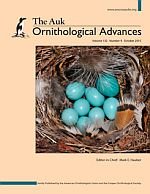Although sex biases in survival and dispersal are thought to be linked to avian mating systems, little is known about these demographic patterns in less common mating strategies such as polygynandry. We investigated breeding-site fidelity, natal philopatry, and apparent survival of the polygynandrous Smith's Longspur (Calcarius pictus) over a 7-yr period at 2 areas in Alaska's Brooks Range. We used capture–recapture histories of 243 color-banded adults and 431 juveniles to estimate annual survival and determined dispersal patterns from 34 adults that were found breeding within the study areas over multiple years. Most adults (88%) returned to nest in the same breeding neighborhood as in previous years; mean dispersal distance was 300.9 ± 74.2 m and did not differ between sexes. Juveniles exhibited low natal philopatry; only 4% of banded hatch-year birds were resighted as adults during subsequent years. Those that did return dispersed, on average, 1,674.4 ± 465.8 m from their natal nests (n = 6). Model-averaged survival estimates indicated that annual survival of adult females (50–58%) was only slightly lower than that of males (60–63%); juvenile survival was 41% but was paired with a low (13%) encounter probability. We attribute the lack of sex bias in adult dispersal to this species' polygynandrous mating strategy. Within this system, there are multiple mates within a breeding neighborhood. We argue that natural selection may favor females that remain on the same, familiar breeding site, because they do not have to disperse to a new area to find a suitable mate. Dispersal among breeding populations most likely occurs by juveniles returning as adults. Our findings support hypotheses that suggest a relationship between dispersal and mating strategy and provide some of the first insight into the demographic patterns of a polygynandrous passerine.
How to translate text using browser tools
30 September 2015
Dispersal and survival of a polygynandrous passerine
Heather R. Craig,
Steve Kendall,
Teri Wild,
Abby N. Powell
ACCESS THE FULL ARTICLE

The Auk
Vol. 132 • No. 4
October 2015
Vol. 132 • No. 4
October 2015
Arctic
breeding-site fidelity
Calcarius pictus
mark–recapture
natal philopatry
Smith's Longspur




